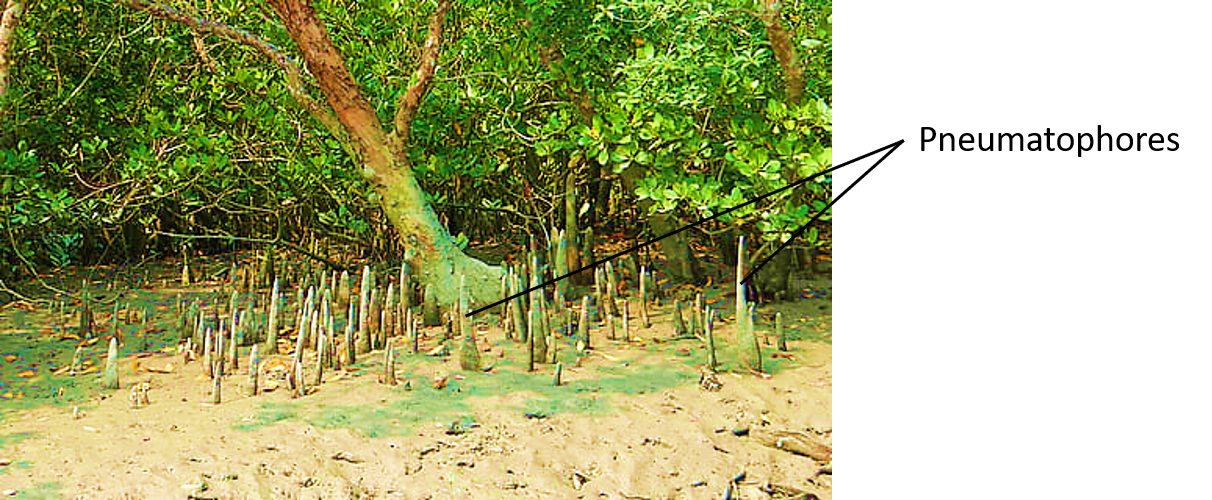Answer
394.8k+ views
Hint: An aerial root system that is specialized for the gaseous exchange in plants. Found mainly in coastal area plants like mangroves arranged in the opposite direction of the usually occurring roots.
Complete answer:
Mangroves grow in the salt marshy soil producing pneumatophore, which is a type of root which grows negatively geotropic for taking in oxygen from the air. They are pencil-like roots that stick up out of the dense, wet ground like snorkels.
Respiratory roots - these roots are found in the plants which grow in marshy areas and are aquatic. In aquatic plants floating roots act as respiratory roots. In marshy areas, the roots are unable to get sufficient oxygen to respire and hence it grows upwards
Mangrove pneumatophores vary in size and morphological characteristics. The black mangroves (Avicennia spp.) have pencil-like or fingerlike pneumatophores, while those of Sonneratia species are conical. Pneumatophores are usually seen as unbranched, but branching can occur when they get damaged. A pneumatophore height is generally measured to have less than 30 cm for Avicennia, less than 20 cm for Laguncularia, and from 30 to 3 m for Sonneratia species, size varies according to the species. Pneumatophore density is typically measured large; as for an example, a 2–3 m-tall Avicennia marina tree usually contains about 10,000 pneumatophores.

So the correct answer is, ‘‘saline marshy soil.’’
Note: Pneumatophores are a type of respiratory root which helps for the respiration for the plants which grow in aqueous and marshy lands and so the roots are grown towards making it negatively geotropic. These aerial roots are beneficial for the coastal plants and control flood and other calamities to an extent.
Complete answer:
Mangroves grow in the salt marshy soil producing pneumatophore, which is a type of root which grows negatively geotropic for taking in oxygen from the air. They are pencil-like roots that stick up out of the dense, wet ground like snorkels.
Respiratory roots - these roots are found in the plants which grow in marshy areas and are aquatic. In aquatic plants floating roots act as respiratory roots. In marshy areas, the roots are unable to get sufficient oxygen to respire and hence it grows upwards
Mangrove pneumatophores vary in size and morphological characteristics. The black mangroves (Avicennia spp.) have pencil-like or fingerlike pneumatophores, while those of Sonneratia species are conical. Pneumatophores are usually seen as unbranched, but branching can occur when they get damaged. A pneumatophore height is generally measured to have less than 30 cm for Avicennia, less than 20 cm for Laguncularia, and from 30 to 3 m for Sonneratia species, size varies according to the species. Pneumatophore density is typically measured large; as for an example, a 2–3 m-tall Avicennia marina tree usually contains about 10,000 pneumatophores.

So the correct answer is, ‘‘saline marshy soil.’’
Note: Pneumatophores are a type of respiratory root which helps for the respiration for the plants which grow in aqueous and marshy lands and so the roots are grown towards making it negatively geotropic. These aerial roots are beneficial for the coastal plants and control flood and other calamities to an extent.
Recently Updated Pages
How do you arrange NH4 + BF3 H2O C2H2 in increasing class 11 chemistry CBSE

Is H mCT and q mCT the same thing If so which is more class 11 chemistry CBSE

What are the possible quantum number for the last outermost class 11 chemistry CBSE

Is C2 paramagnetic or diamagnetic class 11 chemistry CBSE

What happens when entropy reaches maximum class 11 chemistry JEE_Main

Calculate the volume occupied by 88 gram of CO2 at class 11 chemistry CBSE

Trending doubts
Difference Between Plant Cell and Animal Cell

Difference between Prokaryotic cell and Eukaryotic class 11 biology CBSE

Fill the blanks with the suitable prepositions 1 The class 9 english CBSE

Change the following sentences into negative and interrogative class 10 english CBSE

Summary of the poem Where the Mind is Without Fear class 8 english CBSE

Give 10 examples for herbs , shrubs , climbers , creepers

Write an application to the principal requesting five class 10 english CBSE

What organs are located on the left side of your body class 11 biology CBSE

What is the z value for a 90 95 and 99 percent confidence class 11 maths CBSE



